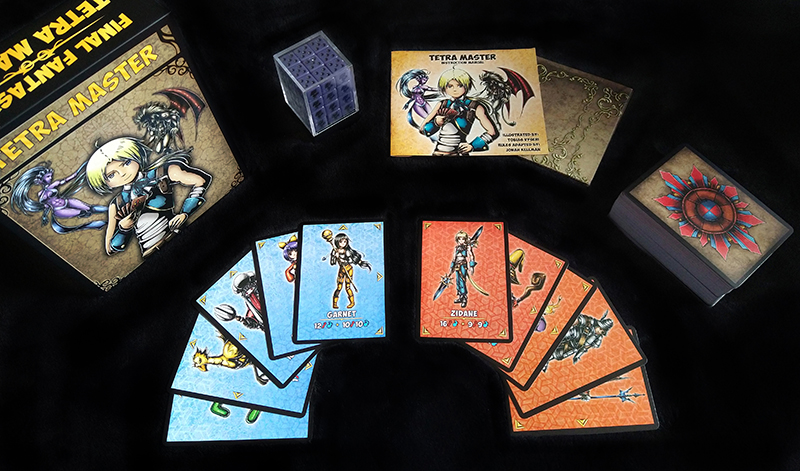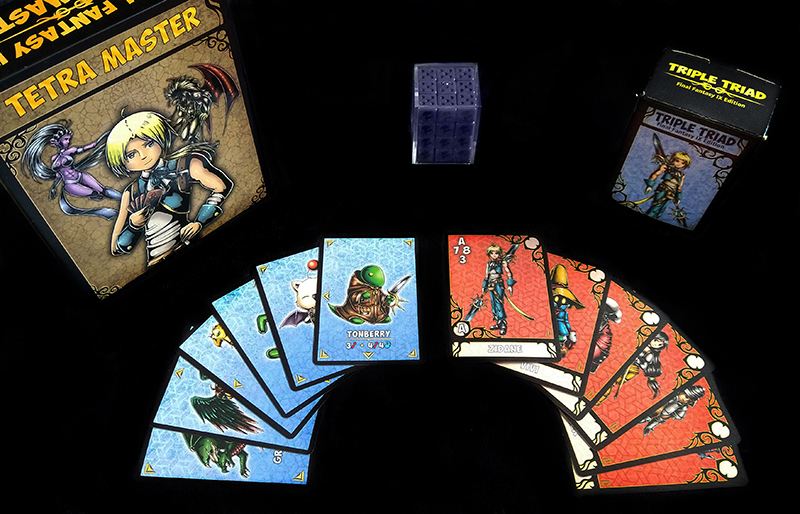 Tetra Master
Blue Card Fronts | Red Card Backs |
Block Deck | Instruction Booklet
Purchase on Etsy
Triple Triad FFIX
Blue Card Fronts | Red Card Backs | Instruction Booklet
Purchase on Etsy
Tetra Master
Blue Card Fronts | Red Card Backs |
Block Deck | Instruction Booklet
Purchase on Etsy
Triple Triad FFIX
Blue Card Fronts | Red Card Backs | Instruction Booklet
Purchase on Etsy
Concept
This one came along as a commission. Occasionally people who see my Triple Triad ask me to make Triple Triad sets for other Final Fantasy games. (XIV being the most common, but FFVII as a close second.) People also, surprisingly, ask me for Tetra Master. One in particular offered to do it as a commission, and a very “hands-off” commission at that. Basically a “make this exist in the world please”. It was the start of the pandemic when I got the request and, knowing I’d have a lot of free time in the near future, I decided to take it on after my other projects were knocked out of the way.
Method
It was mid-July 2020 when I started working on this in earnest. The first step was to start drawing monsters. There were about 100 of the darn things to draw, so I knew that would be the bulk of my work. Unlike the original Triple Triad, I decided to draw them on the tablet first since I had completely ported my workflow to digital.
While I was motoring away for hours at a time, I was also thinking about some of the other challenges, such as how to adapt the digital rules to physical play, since Tetra Master has a lot of RNG elements and a bunch of cryptic backend. Ironically, the shrouded nature of Tetra Master's internal mechanics were a great source of frustration for players, so I knew one of my goals would be to simplify and clarify a lot of those mechanics, without losing the core “feel” of the game.
However, writing rules isn't really my thing, so to accomplish this I turned to someone who I had worked with in a game development capacity in the past, Jonah Kellman. The first mechanic we needed to sort out was how to generate “blocks” on the arena. In Tetra Master the game randomly blocks off parts of the field to keep people from placing cards there. Tokens were suggested, but I wanted to keep cards as the main item because printing cards is much cheaper than most other "board-gamey" elements. We discussed a few methods, like randomly determining whether a square was “blocked” with a series of die rolls, but ultimately I wanted setup to be quick and easy and the best way to do that was to deal cards from a separate deck. Jonah worked out a reasonable ratio to keep the probability of blocking areas off somewhat similar to Final Fantasy IX. My part in this was to develop the cards and board. I first created the board. The in-game board is a weird blue galaxy looking thing, with the block cards abnormally floating over it.
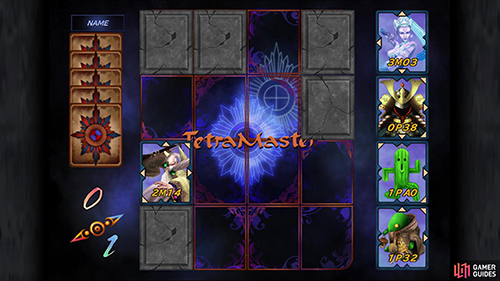 The battlefield in FFIX
The battlefield in FFIX
I felt like the blue clashed a lot with everything else that was going on and decided to go for a more neutral brown color to match the blocks more. (Which were going to look like, you know, actual blocks.) The initial design of the board actually had an intricate rock design based on the courtyard in Alexandria in the background. Unfortunately, when I overlaid the placement rectangles it was too cluttered.
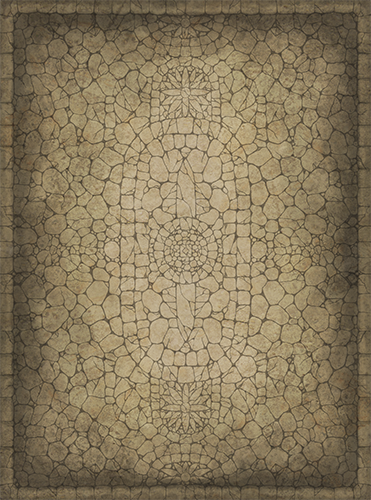 The board before placement rectangles were added
The board before placement rectangles were added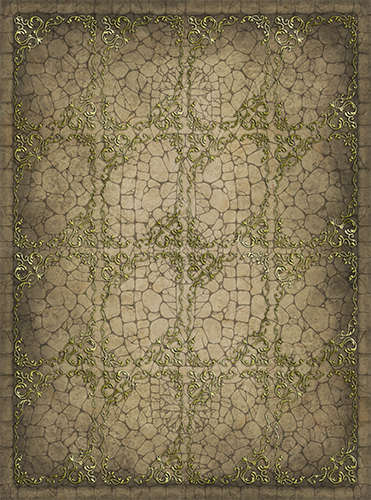 Placement rectangles make this too cluttered
Placement rectangles make this too cluttered
I spent... a while drawing those rocks. But an important design principle is being able to throw stuff in the trash if it doesn’t look good in the end. I ended up going for something much simpler.
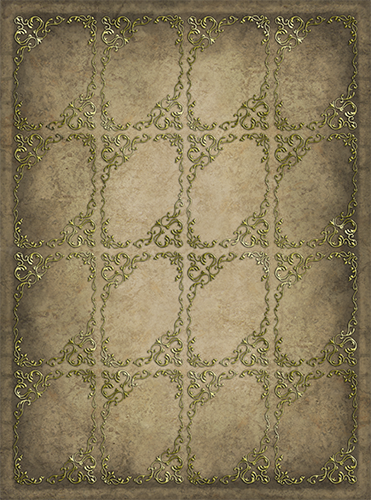 Goodbye, rocks
Goodbye, rocks
The next thing was the blank and block cards. For the block cards I used the crystal that’s featured prominently in the game’s logo as a feature on the rocky “block”. For the blank cards I just used a blank board space to keep things simple.
.png) Block Card
Block Card2.png) Blank Card
Blank Card
Another thing I needed to do was make a card back, this wasn't necessary for the FFVIII version of Triple Triad, but since the block deck cards need to be randomized, it's mandatory here. This wasn’t too hard, since I could stay fairly close to the in-game graphics for this one.
3.png) Block Deck Cardback
Block Deck Cardback
The next thing to work out was how to determine what direction cards “fought” in. This requires a little background. In the digital version of Tetra Master, whenever someone played a card the computer would generate arrows on the card and the card would only interact with other cards if its arrows were pointing at them. This was one of the pain points for the original Tetra Master since this made it difficult for players to strategize and plan their moves. A few solutions to this were discussed. One was having transparent arrow cards (similar to those used in Gloom) that players would place over top of cards after they were played. I was in favour of allowing players to choose the transparency they wanted, but a randomized deck was also discussed.
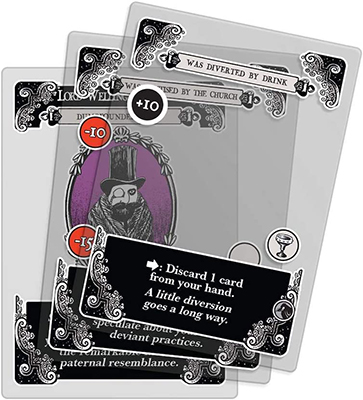 Gloom Card Game
Gloom Card Game
Ultimately, we decided on having arrows assigned to cards. This was for a few reasons. First, not being randomized meant that there wasn’t that annoying “RNG ruined my plan” issue that was rampant in the original Tetra Master. Second, this precluded the need for transparent cards, which were problematic in a few ways. Not all printers are able to print transparent cards, transparent cards are costly and it was hard to get quotes for them, and finally figuring out what arrow configurations to include and exclude from the deck seemed like a headache, since there are a LOT of different combinations and including them all would result in a huge deck.
6.png)
40.png)
The next issue was to figure out how cards would actually fight each other. One of the nice things about Triple Triad is that it’s very simple and elegant; if my card has a bigger number than your card, it wins. In Tetra Master it’s not like that. Without going into too much detail (and also because I don’t actually have a great idea of how it works myself), each card has a power stat which is a number that corresponds to a range of numbers. Whenever the computer needs to calculate a card’s power it randomly picks a number within that range to be the power. The card also has a “battle class” which is basically something that states which defense the attack will be applied against. Then the card will have a physical and magical defense, which are similar to the attack stat, meaning they’re both represented by numbers which actually represent number pools.
You are probably beginning to understand why this game was so frustrating for players.
While a computer randomly picking a number between arbitrary values is annoying, something that players are much more okay with is rolling dice. I think it makes them feel more in control. So, we decided to have the RNG elements in battles replaced with die rolls.
We decided that each monster has an attack number (either physical or magical) and two defense numbers. When cards fight, the owner rolls a number of d6s equal to the number on their card and the appropriate defense. They then compare both numbers and whoever has the larger number wins. We also created a variant where both players only compare the amount of 6s rolled in their die pools instead of having to add large amounts of dice. This meant that I would need dice. Neither of us could think of a way around this, unless we just made the values static, but this would result in us losing a lot of the feel of the game and I felt like it was a bad idea. So I began to look into dice, and more specifically, custom dice. I wanted to have a chocobo on the 6! Initially I sent in a chocobo silhouette, but was told it was too detailed, they offered to just put the head on the die. Instead, I simplified the bird making it look more chibi.
You are probably beginning to understand why this game was so frustrating for players.
While a computer randomly picking a number between arbitrary values is annoying, something that players are much more okay with is rolling dice. I think it makes them feel more in control. So, we decided to have the RNG elements in battles replaced with die rolls.
We decided that each monster has an attack number (either physical or magical) and two defense numbers. When cards fight, the owner rolls a number of d6s equal to the number on their card and the appropriate defense. They then compare both numbers and whoever has the larger number wins. We also created a variant where both players only compare the amount of 6s rolled in their die pools instead of having to add large amounts of dice. This meant that I would need dice. Neither of us could think of a way around this, unless we just made the values static, but this would result in us losing a lot of the feel of the game and I felt like it was a bad idea. So I began to look into dice, and more specifically, custom dice. I wanted to have a chocobo on the 6! Initially I sent in a chocobo silhouette, but was told it was too detailed, they offered to just put the head on the die. Instead, I simplified the bird making it look more chibi.
 Initial Design
Initial Design Final Design
Final Design
Getting dice made for the game was very exciting since it was my first time doing something like this, and this was beginning to feel more and more like a “board game”. I picked the die color and accidentally mis-communicated about the pip color, ending up with black instead of the white I wanted. I think upon reflection I should’ve gone with the blue dice and not this weird purple I chose, but I’m glad I tried it out and will definitely change things up if I do a second print run. Even with the mistakes I’m still so thrilled about getting custom dice. When determining the numbers that would be on the cards, we had values max out at 16 since the dice came in sets of 36, and if both people had to roll 16 dice we wanted to ensure that would work properly and also have a bit of wiggle room so people weren’t using every last die.
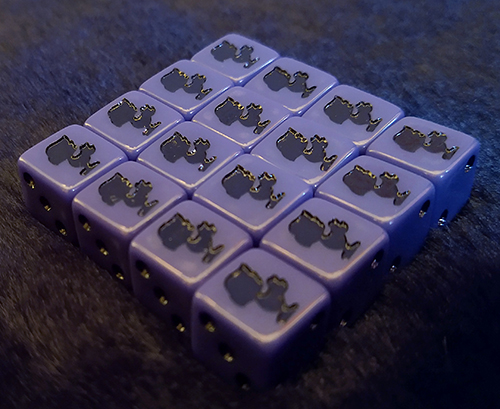 Dice!
Dice!
Whew! By this time this was shaping up to be a bit of a monster project. In the digital version of Tetra Master cards also level up and get stronger the more you use them. We talked about a few ways to implement this (tokens, “stage 2” versions of cards etc.) but in the end I decided that things were complex enough and that I didn’t want to design a Euro board game. So the level-up mechanic was cut entirely. The only real thing left to do was to draw. And draw I did. There were a LOT of drawings for this game, but I’m quite pleased with how most of them came out; my art has improved a lot since I made that first Triple Triad set. It was really difficult to find reference images for some of the cards. This provided some interesting challenges, since for at least a few the low resolution in-game Tetra Master card was the best I could find. Also something else I noticed near the end was the fact that these cards weren’t just characters and monsters like in Triple Triad. Some truly bizarre things were featured, like specific items and places.
74.png) This is just a regular-looking ribbon
This is just a regular-looking ribbon66.png) I'm summoning... a city?
I'm summoning... a city?
when I was almost done I realized that none of FFIX’s characters were featured in the Tetra Master game. I thought this was odd but shrugged it off. However as I was nearing completion I made the decision to release a Final Fantasy IX version of Triple Triad with all the art I’d created. I wasn’t confident that Tetra Master would actually sell well due to the fact that the game itself wasn’t well-received by fans, and I had been asked multiple times for a Triple Triad featuring FFIX characters and monsters. I did a little research online and found a very old blog that already statted out a set of FFIX Triple Triad cards. I reached out to the writer and asked if I could use their statblocks for my physical set of cards, and they said it would be okay. However, I felt like since the FFVIII version of Triple Triad had character cards, this one should as well. Having already drawn 110 pieces of art, I figured another 10 wouldn’t hurt. I reached out to some of my friends who were very familiar with FFIX to see what would be the best characters to include and got to work.
110.png) Zidane for the Triple Triad set
Zidane for the Triple Triad set109.png) Garnet for the Triple Triad set
Garnet for the Triple Triad set
After drawing the characters I thought to myself “why not include these in the Tetra Master set as well?” After all, I was already making them, and the cost of a few extra cards in each set would be fairly negligible. The issue was in how to stat each card, since unlike the rest, there were no predefined stats. I reached out to Jonah with two requests; the first was to stat the character cards, and the second was to push them so that they were awesome and cool and the best cards in the game. He came up with the idea of having their attack stat be “flexible”, meaning they would attack the lower of the opponent’s two defense stats. I liked this as a solution since it meant they were unique and powerful without necessitating the need for more dice. The only character cards that don’t have flexible attack stats were the wizard (who has the highest magic attack in the game) and the fighter (who has the highest physical attack in the game).
108.png) Black Mage
Black Mage106.png) Fighty Fighter
Fighty Fighter
Finally I needed to design an instruction booklet and a card box. I discussed with the printer different box sizes and opted for a box that was slightly larger than required, since I wanted to put this item in game stores. Also, due to the dice, the printing costs were going to be quite high, and I’d heard that it’s easier for a customer to justify paying a higher price if the box is larger, since it feels like they’re getting more for their money.
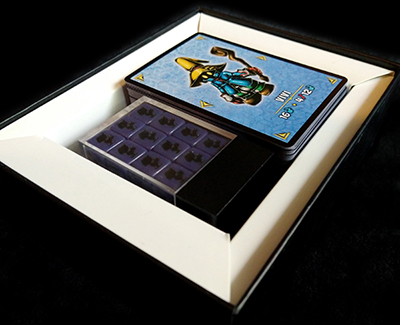 Inside of Box
Inside of Box
There was some miscommunication about the instruction manual and I ended up with a smaller manual than was necessary (based on the box size). Like the dice color, this was a little disappointing, but not a deal breaker. As for the text, I let Jonah take care of it, and he did a great job! Something that wasn't disappointing was the cardstock; It's a great-feeling linen cardstock that shuffles like a dream.
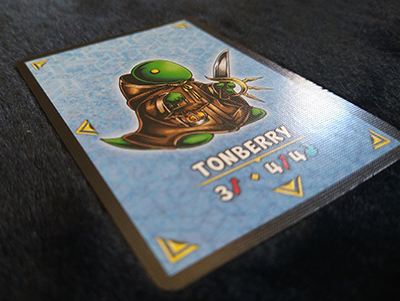
Finally I needed to design the box. I recycled that rock pattern from earlier for the box background.
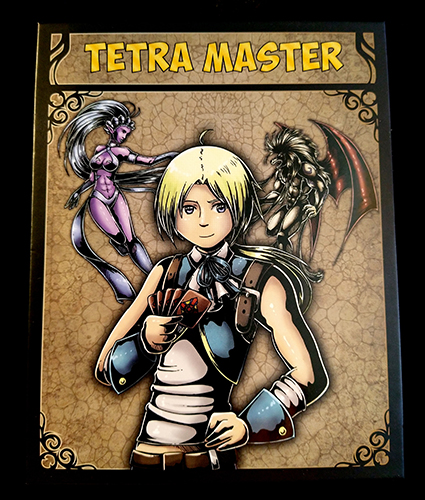 Final Box
Final BoxReflection
This project kind of got away from me. It was supposed to be a fairly light project that was mostly just grinding away at artwork, but ended up being a massive system redesign, as well as an exploration into board game boxes, dice, and multiple sets of cards and paper inserts. I’m really glad I got to do it though, since I got a lot of great experience working with different box sizes and lots of small pieces, which I wouldn’t have otherwise gotten.
